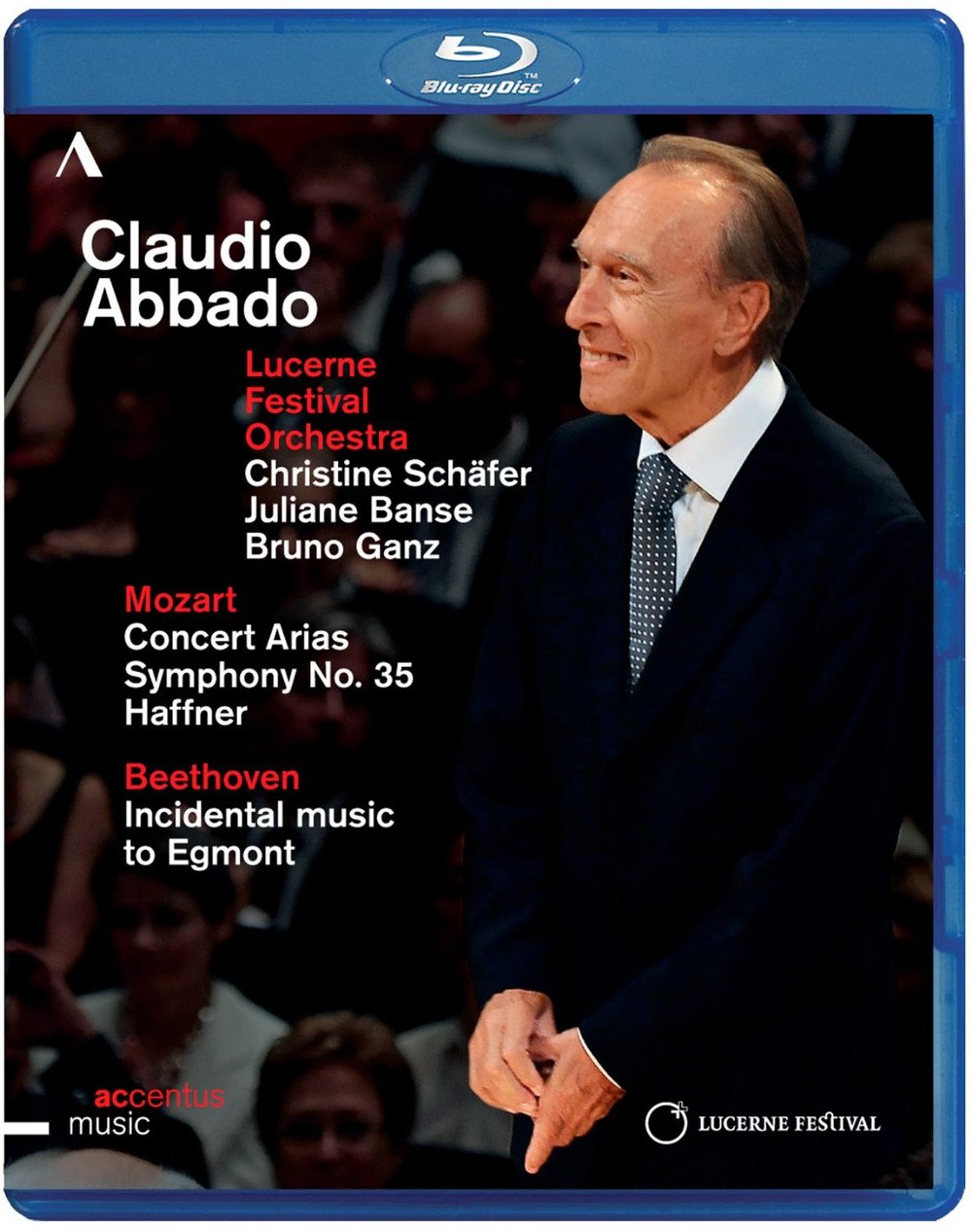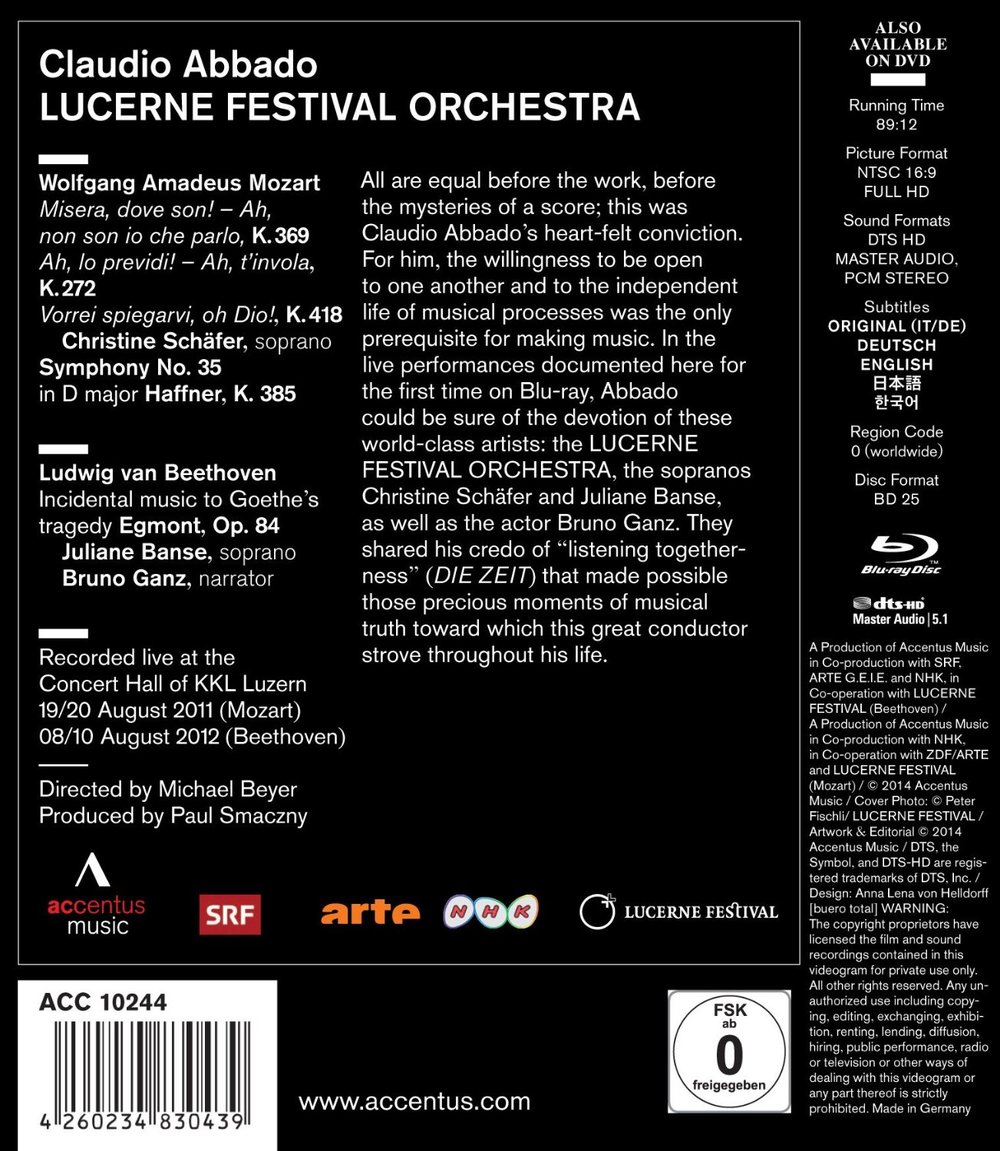

Mozart Symphony No. 35 concert. Here's the program:
Mozart concert arias sung by soprano Christine Schäfer:
Misera, dove son? - Ahi! non son io che parlo, K. 369
Ah, lo previdi! - Ah, t'invola, K. 272
Vorrei spiegarvi, oh Dio! K. 418 (Lucas Macias Navarro, oboe)
Mozart Symphony No. 35 ("Haffner")
Beethoven Egmont Incidental Music with soprano Juliane Banse and narrator Bruno Ganz
Claudio Abbado conducts the Lucerne Festival Orchestra in 2011 and 2012 at the Lucerne Summer Festival (KKL Concert Hall). Directed for TV by Michael Beyer; produced by Paul Smaczny. Released 2015, disc has 5.1 dts-HD Master Audio sound. Grade: B- blended grade for 3 segments.
Mozart Concert Arias
Various composers, and especially Mozart, wrote short, opera-style vocal pieces with rich orchestration, often as showcases for particular singers who would show off their skills in concerts. There's usually enough text for the singer to create a highly dramatic scene that can be appreciated in isolation. Accentus doesn't provide any lyrics or discussion of the three arias recorded here. The subtitles are not all that great either. But in the first two screenshots of Christine Schäfer below, you start to understand what these arias typically are about — a noble woman is trapped by the actions of the men around her in a situation from which death is the only escape:
The angles above are "realistic" shots of Schäfer, and there are 74 of these in the video. The shot below (with Schäfer singing of grim pain) is "not realistic" because it's not a view that the audience could share:
And why would the videographer make a shot of Schäfer's back even once? This is really a tacky thing to do:
But the next shot below can be justified. The orchestra gets the lead for a few bars, and even Schäfer is enjoying it:
Below is a rare shot of most of the violins:
Schäfer is fantastic in this nailing down notes that a lot of good sopranos probably can't reach. The audience loved her:
I did our usually analysis of video content and arrived at an A grade for Schäfer's part of this title. To learn more about how we grade symphony titles and the dread disease "DVDitis", see our special article on how to make a decent video of a large orchestra for viewing on HD TV. Briefly, DVDitis is a malady that afflicts Blu-ray videos with content that is only appropriate for a DVD. We use a Wonk Worksheet to accurately diagnose DVDitis in a Blu-ray recording. For more information, see our blank Wonk Worksheet form and Wonk Worksheet Instructions.
Mozart Symphony 35
We did not detect much DVDitis in the concert arias above. But the video of Mozart Symphony 35 has a textbook, full-blown case of the malady. See our Wonk Worksheet for Mozart Symphony 35. Now let's review the different kinds of video clips one encounters when watching a symphony video. Below next is an example of a simple conductor shot (C). Per the WW, there are 35 shots like this for this Mozart S35:
Next below is a conductor-over-backs shot (C/B); there are 31 shots like this in the video:
Here next below is a typical small-scale shot, one of 93 in the symphony:
The shot of the basses below is arguable a large-scale shot because it's an entire string section:
Next below is a large-scale shot for sure with 8 violins:
Then there are 7 part-orchestra (PO) angles in the video similar to what you see below:
Every good symphony video should have many shots of the whole orchestra (WO). This video segment has none. It does have 3 "anthill" views. These are made from so far away that you can't easily made out much about the band:
The next angle below also isn't a WO shot because the camera is too low. All you can see well are musicians on the edge of the stage:
And lastly we see an example of an instrument-only (IO) shot:
Every symphony video might be consider an organic molecule consisting of a complex grouping of the video elements or atoms illustrated above. The best symphony videos are made up mostly of the large-scale views that we call "supershots." Now it just happens that we have a video of Mozart's Symphony No. 35 from the Mito Chamber Orchestra that is, in our view, one of the best symphony videos ever made (and graded A+ on this website). Next below is a table that compares the Mito Chamber Orchestra video to the Lucerne Festival Orchestra version we are now studying:
The Lucerne Festival version flunks the 3 tests for DVDitis that we express as follows:
A good HDVD should have a slow pace with more than 10 seconds per video clip on average (longer the better). 20 to 40% (higher is better) of the clips should be large-scale "supershots". Conductor shots should be less than 20% (way less really) of the clips in the video.
Subject video was made to look good on a SD TV display showing a DVD. That's why it has all those small-scale and conductor views. Those are the only kind of shots that look good in a low-resolution DVD. This is obsolete, defective, and unacceptable in the Blu-ray format. HD cameras with high resolution can make both the the large-scale supershots and the small-scale shots look great. Modern videography shows the big picture first and adds the small-ball stuff later.
When, as is this case, a disc flunks all three tests of DVDitis, we grade it down to D. The grade of D on this website means that you should buy the title only if you have a special reason to overlook the deficiencies indentified.
Egmont
Beethoven's Egmont is the last and longest segment of this concert. And as our Wonk Worksheet shows, the two 2 soloists help to pass the supershot test and hold down the number of conductor shots. And suddenly, the videographer decides to give us 12 nice whole-orchestra shots like the one next below. I'm guessing the Egmont was recorded a year later than the Mozart symphony:
And here's a beautiful large-scale shot of the entire double bass section:
Next are two shots of the energetic and athletic Juliane Banse:
Banse is one of those heroine sopranos (like Nadja Michael, Kristine Opolais, and Isabel Leonard) who can pull off anything on stage. Below you see her repeatedly climbing up and down from a wet lavatory basin, without safety measures and with a rope around her neck, in Martin Kušej's production of Genoveva:
And now we see and hear Bruno Ganz narrating across the stage. This has got to be one of worst shots of a soloist ever put into a symphony video:
Ganz is, of course, speaking, not singing, a text written by Goethe:
Ganz is most famous for his role as Adolf Hitler in the movie Downfall; his resemblance to Hitler is only general, but his portrayal is considered definitive:
Here the narrator is the hero Egmont, who fights and dies for freedom:
Per the WW, this segment flunks the pace and conductor tests for DVDitis, which would bring the grade an A to a C. But for improved SQ, PQ, and the rare chance to see both Banse and Ganz in this, I moved the grade up to B.
OR

























